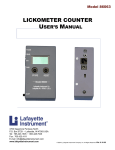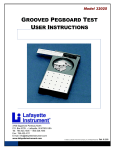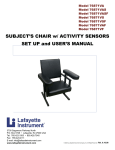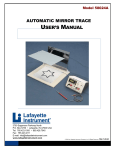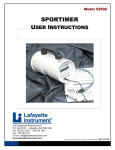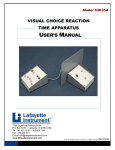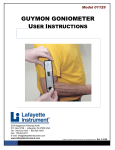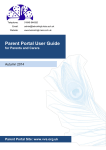Download ELECTRONIC VOICE REACTION TIMER
Transcript
Model 63040A User’s Manual Model 63040A ELECTRONIC VOICE REACTION TIMER USER’S MANUAL 3700 Sagamore Parkway North P.O. Box 5729 • Lafayette, IN 47903 USA Tel: 765.423.1505 • 800.428.7545 Fax: 765.423.4111 E-mail: [email protected] www.lafayetteinstrument.com © 2003 by Lafayette Instrument Company, Inc. All Rights Reserved-Rel. Fax: 765-423-4111 . www.lafayetteinstrument.com . E-mail: [email protected] 3.10.03 2 ELECTRONIC VOICE REACTION TIMER System Description: The Electronic Voice Reaction Timer Model 63040A is a dual channel voice activated relay. Each channel is independent and may be activated by either a piezo microphone, a throat microphone, or a manual pushbutton all of which are supplied with each unit. A microprocessor is employed to provide overall control of the unit's functions. It operates in four different modes, which are Latched or Non-latched and Sequential or Non-sequential. Up to three relay outputs can be used with external devices, such as counters, timers, or external stimulus devices. This unit uses photomos relays to prevent high frequency noise from causing false triggering of the analog circuitry, as can happen with solenoid relays. 2 3700 Sagamore Parkway North . PO Box 5729 . Lafayette, IN 47903 USA . Ph: 765-423-1505 Model 63040A User’s Manual 3 User Instructions: 1. Plug the 12 Volt wall mount powerpack into Model 63040A and into an AC socket. 2. Plug a microphone into mic 1 input, and another microphone or hand-held switch into the mic 2 input. Turn the microphones on. 3. Turn unit on, and wait for initial messages to cycle on the LCD display. 4. The next message to be displayed will be the following; LATCH MODE? YES NO When in the latch mode, the relay contacts will close upon receiving an input from the corresponding microphone channel, and the relay will remain closed until manually reset by the user. Choose the mode desired by pressing the button directly beneath the choices; Yes or No. If the Non-latched mode is selected, a microphone trigger will cause a momentary closure of the relay contacts. The closure time is determined by the amount of delay that is selected. The range for delay is from 0 - 2 seconds, selectable in 10 millisecond increments. This is further described in Non-latching/Sequential Mode, instruction # 6 (pg. 5). 5. Once the type of latching mode is determined, the next message to be displayed will be the following; SEQUENTIAL MODE? YES NO When in Sequential mode, microphone 1 must cause a trigger input before the unit will accept any input from microphone 2. Again, the mode is chosen by pressing the button that is directly below the choices given, YES or NO. In non-sequential mode, an input on either microphone will cause the corresponding relay to close. 6. Once the choice is made for the sequential mode, the unit will be in one of four modes of operation; 1) Latching/Sequential Mode, 2) Latching/Non-sequential Mode, 3) Non-latching/ Sequential Mode, or 4) Non-latching/Non-sequential Mode. The microphone sensitivity is set to a default value of 25%, and the relay-on delay is set at 0.50 seconds. These settings can be changed, and once changed, they will remain at the new settings until they are changed again by the user, no matter if the mode of operation is changed. However, if power is interrupted to the unit, the settings will go back to the default values. Fax: 765-423-4111 . www.lafayetteinstrument.com . E-mail: [email protected] 3 4 ELECTRONIC VOICE REACTION TIMER Latching/Sequential Mode 1. If the Latching/Sequential Mode is selected the next message to be displayed is the following; VOL QUIT RUN If the microphone sensitivity settings are to be changed, the button directly under the VOL should be pressed. If you wish to leave this mode, press the button under QUIT. If the mode and settings are satisfactory, and you wish to begin testing, press the button under RUN. 2. If the sensitivity is to be adjusted, the following screen will appear on the display; PICK MICROPHONE MIC1 MIC2 OK Select the microphone that you wish to adjust by pressing the button underneath MIC 1 or MIC 2. This will bring up a new screen in which the current sensitivity setting is displayed in percentage of maximum sensitivity and the following choices will be displayed; INC DEC OK Pressing the INC button will increment the sensitivity in 1% increments. If the button is held down, the sensitivity will increment at a moderate rate for the first five increments, and then will increment at a much faster rate, until the button is released. The same is true for the DEC button, except that the sensitivity will decrement. Once the sensitivity setting for that microphone is at the desired value pressing the OK button will bring you back to the PICK MICROPHONE screen. Pressing the OK button will take the user back to the previous screen. 3. If all the settings are acceptable, pressing the RUN button will allow testing to begin. The LCD displays the following screen; REAC TIME=0.000S VOL QUIT At this point, a trigger input from microphone 1 will cause four things to occur. First, Relay 1 contacts will close and latch and the green indicator LED for input mic 1 will turn on. At the same time, Relay 3 contacts will close and the reaction time display will start running. Pressing the QUIT button at this point will open relay 1 and 3 contacts, shut off the green LED, and reset the clock. If the QUIT button is not pressed, the clock will continue to run until a input mic 2 trigger is received. At this point, Relay 2 contacts will close latch while Relay 3 contacts open and the clock display stops running. Again, pressing the QUIT button at this point, will open all closed relays, turn off the indicator LEDs, and reset the clock display. If the QUIT button is pressed again, you will leave this mode of operation, and be taken back to the latch mode selection screen. 4. When in this mode, the microphone sensitivity can still be adjusted, but only when no relays are closed. Once a relay closes, the QUIT (reset) button must be pressed before sensitivity adjustments can be made. 4 3700 Sagamore Parkway North . PO Box 5729 . Lafayette, IN 47903 USA . Ph: 765-423-1505 Model 63040A User’s Manual 5 Latching/Non-sequential Mode 1. In this mode of operation, the displays are the same as the Latching/Sequential Mode, and the unit operates in almost the same manner. The main difference is that either input mic 1 or mic 2 can initiate the reaction timing sequence of closing Relay 3 contacts and starting the clock display. Mic 1 trigger still latches Relay 1 and a Mic 2 trigger still latches Relay 2. 2. Relay 3 closes when the first microphone trigger occurs and opens upon the reception of the second trigger on the other microphone. Non-latching/Sequential Mode 1. When the Non-latching/Sequential Mode is selected the display will read the following; TESTING VOL DLY QUIT 2. At this point, testing can immediately begin. Since this is a sequential mode of operation, microphone 1 must produce a trigger input before microphone 2's input will become valid. If microphone 1 has produced a trigger, and microphone 2 has not produced a trigger, the unit will ignore microphone 1's inputs until microphone 2 has produced a trigger input. 3. Once triggered, the corresponding relay will close for the amount of time determined delay. 4. The microphone sensitivity levels can be changed at any time by pressing the VOL button and following the procedure that was outlined in Latching/Sequential Mode, instruction # 2 (pg. 4). 5. If the delay is to be adjusted, the user is to push the button underneath DLY on the display. The next screen will display the following; SELECT RELAY RLY1 RLY2 OK Pressing the OK button will bring you back to the testing mode. Pressing RLY1 button will allow the user to adjust the "relay close" period for Relay 1. Pressing the RLY2 button is for adjusting this time for Relay 2. Fax: 765-423-4111 . www.lafayetteinstrument.com . E-mail: [email protected] 5 6 ELECTRONIC VOICE REACTION TIMER Regardless of which relay is chosen to be adjusted, the next screen to appear on the LCD is the following; DELAY = 0.500S INC DEC OK 6. The delay period can now be incremented in 10 millisecond steps by pressing the INC button. The maximum delay is 2.000 seconds. Conversely, the delay period can be decremented in 10 millisecond steps by pressing the DEC button. The minimum delay is 0.000 seconds. When the delay is set to the desired period, pressing the OK button will bring the user back to the previous screen, where the other relay may be selected for adjustment or the OK button can be pressed and testing may begin. When the INC or DEC button is pressed and held, the delay value will change at a moderate rate for the first five values and then change at a much faster rate until the button is released. 7. In this mode of operation Relay 3 is not used. 8. Pressing the Quit button will cause the unit to exit this mode and return to the main configuration selection screen. Non-latching/Non-sequential Mode 1. When in this mode of operation any trigger input from either microphone will cause it's corresponding relay to close for the time determined by the delay period. 2. The same testing screen as for the Non-latching/Sequential Mode is displayed and the selection menu responds in the same manner. 6 3700 Sagamore Parkway North . PO Box 5729 . Lafayette, IN 47903 USA . Ph: 765-423-1505 Model 63040A User’s Manual 7 System Specifications: Power Supply: 12VDC Power Consumption: 0.75W Frequency Response: 50 - 7000Hz @ 10mVRMS Sensitivity: 4.0mV Output: 3 sets of NO Contacts Contact Rating: 1.0A @ 200V AC/DC Fax: 765-423-4111 . www.lafayetteinstrument.com . E-mail: [email protected] 7 ELECTRONIC VOICE REACTION TIMER ELECTRONIC VOICE REACTION TIMER Model 63040A User’s Manual Ordering Information: All phone orders must be accompanied by a hard copy of your order. All must include the following information: 1) Complete billing and shipping addresses 2) Name and department of end user 3) Model number and description of desired item(s) 4) Quantity of each item desired 5) Purchase order number or method of payment 6) Telephone number DOMESTIC TERMS There is a $50 minimum order. Open accounts can be extended to most recognized educational institutions, hospitals and government agencies. Net amount due 30 days from the date of shipment. Enclose payment with the order; charge with VISA, MasterCard, American Express; or pay COD. We must have a hard copy of your order by mail or fax. Students, individuals and private companies may call for a credit application. INTERNATIONAL PAYMENT INFORMATION There is a $50 minimum order. Payment must be made in advance by: draft drawn on a major US bank; wire transfer to our account; charge with VISA, MasterCard, American Express; or confirmed irrevocable letter of credit. Proforma invoices will be provided upon request. RETURNS Equipment may not be returned without first receiving a Return Goods Authorization Number (RGA). When returning equipment for service, please call Lafayette Instrument to receive a RGA number. Your RGA number will be good for 30 days. Address the shipment to: Lafayette Instrument Company, 3700 Sagamore Parkway North, Lafayette, IN 47904, U.S.A. Shipments cannot be received at the PO Box. The items should be packed well, insured for full value, and returned along with a cover letter explaining the malfunction. Please also state the name of the Lafayette Instrument representative authorizing the return. An estimate of repair will be given prior to completion ONLY if requested in your enclosed cover letter. We must have a hard copy of your purchase order by mail or fax, or repair work cannot commence. WARRANTY Lafayette Instrument guarantees its equipment against all defects in materials and workmanship to the ORIGINAL PURCHASER for a period of one (1) year from the date of shipment, unless otherwise stated. During this period, Lafayette Instrument will repair or replace, at its option, any equipment found to be defective in materials or workmanship. If a problem arises, please contact our office for prior authorization before returning the item. This warranty does not extend to damaged equipment resulting from alteration, misuse, negligence or abuse, normal wear or accident. In no event shall Lafayette Instrument be liable for incidental or consequential damages. There are no implied warranties or merchantability of fitness for a particular use, or of any other nature. Warranty period for repairs or used equipment purchased from Lafayette Instrument is 90 days. DAMAGED GOODS Damaged equipment should not be returned to Lafayette Instrument prior to thorough inspection. When a shipment arrives damaged, note damage on delivery bill and have the driver sign it to acknowledge the damage. Contact the delivery service, and they will file an insurance claim. When damage is not detected at the time of delivery, contact the carrier and request an inspection within 10 days of the original delivery. Please call the Lafayette Instrument Customer Service Department for a return authorization for repair or replacement of the damaged merchandise. Lafayette Instrument Co. Europe 3700 Sagamore Parkway North P.O. Box 5729 • Lafayette, IN 47903 USA Tel: 765.423.1505 • 800.428.7545 Fax: 765.423.4111 E-mail: [email protected] www.lafayetteinstrument.com 4 Park Road, Sileby, Loughborough, Leics., LE12 7TJ. UK. Tel: +44 (0)1509 817700 Fax: +44 (0)1509 817701 E-mail: [email protected] 3700 Sagamore Parkway North . PO Box 5729 . Lafayette, IN 47903 USA . Ph: 765-423-1505








